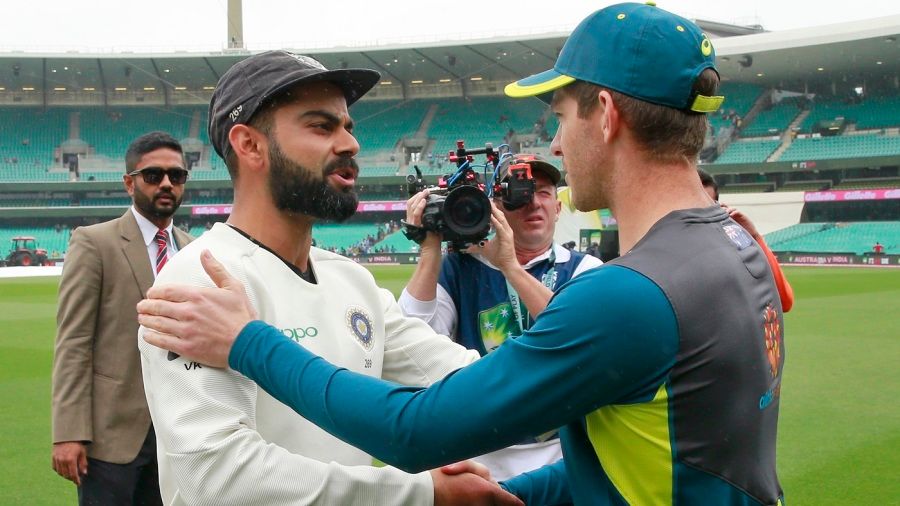Australia and India Clash in Adelaide: A Cricket Classic in Uncertain Times
In a year marked by the Covid-19 pandemic, Australia and India prepare for a new confrontation at the Adelaide Oval, the same venue where their previous series began in 2018. The familiar sight of the scoreboard and the iconic Moreton Bay trees north of the field evoke the tradition of Test cricket, a perfect backdrop for the teams led by Tim Paine and Virat Kohli in India’s first day/night Test away from home. This encounter holds special significance, exceeding the expectations of what was anticipated 20 years ago. The series itself is a triumph, considering the difficulties that arose. Since 1999, India and Australia have contested 12 test series, a number similar to the Ashes series that Australia has played against England in the same period. However, this year, the uncertainty about the series taking place was palpable. In the critical months of March, April, and May, when the sports world ground to a halt, the possibility of the series not happening was real. Even more recently, the obstacles to organizing the event, despite the goodwill between Cricket Australia and the Board of Control for Cricket in India (BCCI), were significant. Cricket Australia, grateful for the absence of complications from the Indian administrators and players, faced logistical challenges, such as finding a point of entry for the charter plane carrying the visiting team. Initial plans to land in Perth were modified, passing through Adelaide and Brisbane before finally settling on Sydney, Canberra, and the government of New South Wales. Negotiations with the Queensland government were a tense and ultimately unsuccessful process. Even after the Indians arrived, a Covid outbreak in Adelaide threatened to disrupt the series. For a long time, it was planned that the Adelaide Oval would host one or two Tests, given the prolonged quarantine in Melbourne, which kept the Boxing Day in doubt until October. However, the outbreak that forced a brief lockdown in South Australia led to considering alternative scenarios, such as starting the series with a day/night Test at the MCG and then playing a more traditional match from December 26th. Damian Hough, the curator of Adelaide Oval, who has dealt with rock concerts and changes in football matches in the past, prepared a pitch for the test match with a Christmas show as a prelude. “One thing we’ve learned with Covid is to live more in the present,” said Hough. “We like to plan months in advance. We still had plans, but we had to live a little more in the moment,” he added. “[A U2 concert last year] was a much bigger challenge than what we are going through this year. I never thought I would see a Christmas parade at Adelaide Oval, so it’s a unique year.” “We are fortunate to be able to offer Australia training in the center court on Friday, Saturday and Sunday, so that was our only preparation, and it seemed to go very well, the comments were positive. We have the recipe that seems to work… we are simply sticking to the game plan.”These center-court sessions represent an invaluable competitive advantage for the Australian players, who arrived earlier than those who played for Australia A against the Indians on a different surface at the SCG, something Paine did not hesitate to affirm.

“But we certainly have plans implemented that have worked well against him in the past; hopefully they’ll work early enough this week, but if not, yes, we have a couple of different plans. The good thing about our attack is that they’re all different, we also have Nathan Lyon and now you add Greeny, we have a few different angles, a few different speeds and obviously Nathan’s spin as well as Marnus’, so we have a lot of different options to bowl at him if he were to get in and get set.” It’s refreshing to focus on tactical discussions and plans on the eve of a test series, rather than Covid protocols, border restrictions, and the financial impacts of the year to date. Paine, who values his test career more than most, after nearly retiring from cricket altogether in 2017, didn’t feel “bubble fatigue” at this point, when asked if such considerations could shorten what remains of his time at the top of the game. “Absolutely not. I love it, to be honest,” Paine said. “I don’t think this hub has been as strict as maybe the IPL or the one in England. I sleep very well at night; my children are at home, which is good in a way, but I certainly miss them. But I sleep better here and feel fresher here than at home, so life in the hub might make me play longer, if anything.” While in recent years there has been some fatigue due to the frequency of encounters between India and Australia, the events of 2020 have ensured that this latest chapter is as vivid as any sporting competition, at a time when so many people around the world remain confined by a pandemic.“Everyone has big plans to get the best players out, right?, but that’s why they are the best, they can adapt, they can change with what you are doing, and Virat is undoubtedly one of the best players, if not the best player in the world”, Paine said. “There will be a moment in this, well, there’s really only one Test, so I hope not, but when you play against players as good as Virat, sometimes they get away from you, that’s the game”.
Tim Paine








